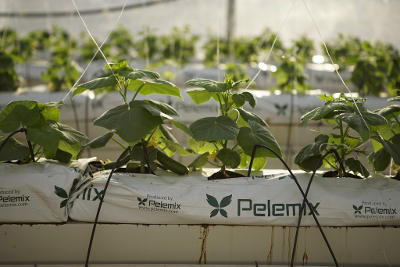Using AI to control energy for indoor agriculture
30 September 2024
Published online 30 September 2017
An agricultural endeavor in Aqaba is using saltwater to alleviate Jordan's strain on food, energy and freshwater production.

© The Sahara Forest Project
Led by the 'Sahara Forest Project' (SFP), a public-private consortium whose donors include the Norwegian government and the European Union, it relies on a combination of sustainable technologies to grow crops using the abundant Red Sea saltwater resources nearby.
It’s a complex set-up; designed to minimize water losses, boost crop yields and save energy.
Jordan is one of the world's most-water stressed countries, and the effects of climate change are putting an extra strain on resources and agricultural production.
"The core idea is to utilize what we have plenty of, such as sunlight, seawater, deserts and CO2, to produce what is most needed: food."
The site for the new facility will expand to 20, contains two saltwater-cooled greenhouses, photovoltaic (PV) facilities, outdoors fields, salt ponds, in addition to a laboratory and office facilities.
Each day, 10 cubic meters of water are abstracted from the Red Sea and delivered by trucks to the facility. Once on site, the saltwater streams down evaporative pads. The water used to make “the air inside the greenhouse […] cooler and more humid,” says Joakim Hauge, SFP's CEO.
The evaporation process is boosted by PV-operated fans which draw the hot desert air through a series of cardboard pads that are designed to condense and collect some of these droplets for generating more freshwater that can be used for irrigation.
Additional freshwater needed to irrigate indoors and outdoor crops is generated by solar-powered reverse osmosis.
The greenhouses' run-off water is also reused to cool, humidify and increase the nutrients intake of the crops growing outdoor. The process goes on until the brine's salt-concentration prevents any more evaporation. The salt-laden liquid is discharged into the adjacent salt-ponds, where it’s used for ordinary salt production.
“The Sahara Forest Project's core idea is to utilize what we have plenty of, such as sunlight, seawater, deserts and CO2, to produce what is most needed: food, freshwater and renewable energy,” says Hauge.
Today’s food, freshwater and energy production challenges can only be efficiently addressed in synergy, he adds.
SFP’s Aqaba farm is the result of eight years of research, for the most part conducted on a pilot project in Qatar, where SFP's engineers, scientists and agronomists tweaked and verified the efficiency of the combined technologies. They grew 19 different crops, including barley, on a plot of land squeezed between an industrial complex and the desert, an hour from Doha.
“The pilot operation in Qatar confirmed that we could achieve similar yields as leading European greenhouses with half the freshwater consumption of traditional greenhouses in the Gulf,” Hauge says. The Qatar pilot, however, was carried out as part of a scientific program and doesn't necessarily reflect what they foresee for large-scale operations, he says.
“We want to focus on plants better adapted to the local ecology, such as dates, native species and fodder, which is why we work in close cooperation with local communities, farmers and ecologists,” adds Hauge.
In Aqaba, SFP plans to produce 130,000 kilograms of vegetables every year to be sold on the domestic market. The vegetables are produced using hydroponic systems and mineral fertilizers inside the greenhouses.
Olav Kjørven, a former assistant secretary for the United Nations Development Program calls SFP's use of sunlight, seawater and biological pest control a “'gold standard for sustainability”.
Samer Talozi, a water expert and associate professor at the Jordan University of Science and Technology in Irbid, praised the project, saying that Jordan's traditional rain-catching reservoirs are outdated and cannot alone meet the country's need for freshwater.
“The concept of looking at water, energy and food holistically can be the solution,” he says. “This project relies on seawater, a resource that has drawn a lot of interest recently because of the falling costs of desalination technology,” he adds.
Talozi believes that as long as the project does not rely on non-renewable sources, it could have a neutral outcome at worst. “It is very reassuring that they won't tap freshwater or fossil fuels, because we already have plenty of such projects harming our ecosystems and economy in Jordan.”
SFP is performing feasibility studies in Tunisia and Australia to ascertain potential for new facilities. “The Sahara Forest Project is not a silver bullet that answers the whole challenge of food, freshwater and energy production, but we wish to be part of the solution,” Hauge says.
doi:10.1038/nmiddleeast.2017.143
Stay connected: